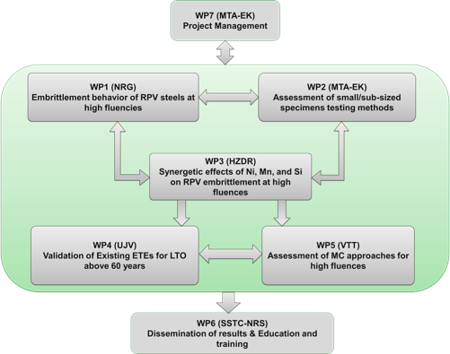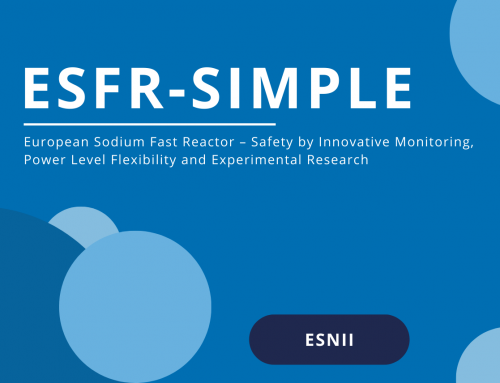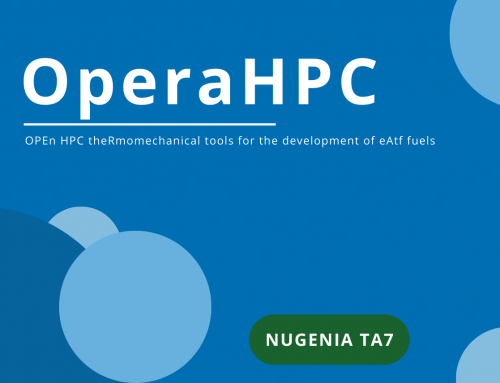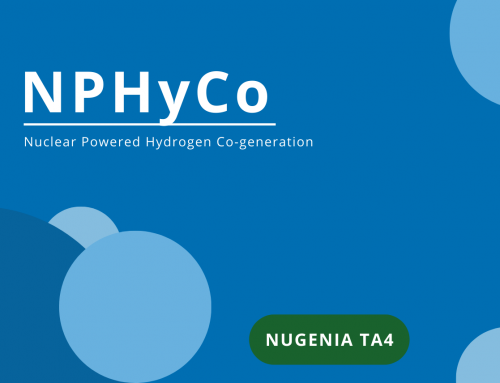
OBJECTIVES
One of the critical issues of long-term operation (LTO) of mainly pressurized water reactors (PWRs) is the embrittlement of the reactor pressure vessel (RPV) caused mainly by neutron irradiation. Substantial research has been performed in various international collaborative research projects, such as LONGLIFE, PERFORM60, SOTERIA, etc., which have helped to improve the understanding of many open issues in RPV ageing phenomena, such as flux effect and influence of chemical/microstructural heterogeneities on RPV embrittlement. Despite all the previous research on RPV embrittlement, there are several open issues. E.g., there are contradicting viewpoints on underlying mechanisms that lead to accelerated embrittlement (i.e., formation of new phases or accelerated growth of existing clusters) at high fluence conditions in certain low Cu RPV steels. Further research focusing on understanding unfavorable synergy between Ni, Mn and Si on microstructure and mechanical properties of RPV at high fluences is needed to elucidate the late irradiation effects. Existing embrittlement trend equations (ETEs) tend to under predict RPV embrittlement at higher fluence regimes. Therefore, subsequent efforts are needed to validate/adapt the ETEs accordingly. In addition, the applicability of master curve (MC) approach at high fluences and small/sub-sized specimens to characterize irradiation induced shifts in reference curves needs to be further investigated. STRUMAT-LTO project is strategically aimed to address these remaining gaps and open issues in RPV embrittlement to support safe long-term operation of LWR NPPs, including the scenario of LTO > 60 years.

DESCRIPTION OF WORK
 NRG and JRC jointly conducted an irradiation campaign in the High Flux Reactor Petten, called Lyra-10 in which a variety of different RPV steel specimens resembling VVER-1000 and western type PWR RPV steels with systematic variations in Ni, Mn and Si contents have been irradiated to high fluences resembling reactor operation beyond 60 years. The goal of STRUMAT-LTO is to address above mentioned scientific gaps in RPV embrittlement by exploiting the Lyra-10 specimens (i.e., post irradiation examination). The scientific work of the project has been distributed into 5 work packages, WP1-WP5 and WP6 is focused on dissemination of results, education and training as outlined in picture on the right.
NRG and JRC jointly conducted an irradiation campaign in the High Flux Reactor Petten, called Lyra-10 in which a variety of different RPV steel specimens resembling VVER-1000 and western type PWR RPV steels with systematic variations in Ni, Mn and Si contents have been irradiated to high fluences resembling reactor operation beyond 60 years. The goal of STRUMAT-LTO is to address above mentioned scientific gaps in RPV embrittlement by exploiting the Lyra-10 specimens (i.e., post irradiation examination). The scientific work of the project has been distributed into 5 work packages, WP1-WP5 and WP6 is focused on dissemination of results, education and training as outlined in picture on the right.

MAIN EXPECTED RESULTS
- Quantitative PIE data on hardening and embrittlement behavior of PWR and VVER-1000 RPV steels at fluences resembling beyond 60 years of reactor operation to fill the existing data gaps
- Comprehensive understanding on the synergetic effects as well as individual role of Ni, Mn and Si on RPV embrittlement at high fluences for low Cu RPV steels
- Validated ETEs and a proposal to improve ETEs for better prediction of RPV embrittlement to support RPV LTO > 60 years
- Improved understanding on the applicability of MC method at high fluences, especially in view of scatter in transition region
- Improved understanding on the applicability of small specimen methods for fracture toughness evaluation
- Knowledge transfer to younger generations in RPV-LTO research and maximise the project impact by involving LTO stakeholders from the beginning to pave way for safe LTO of European NPPs

PARTNERS
EK/ NRG/ LGI/ HZDR/ CIEMAT/ UJV/ BZN/ VTT/ JRC/ UKAEA/ VUJE/ SSTC NRS/ CNRS/ INR NASU/ STUBA/ ARB-NPPS/ IPP CENTRE LLC/ FhG-IZFP/ SEC NRS

DURATION
09/2020 – 08/2024 (4 years)

CONTACT
Coordinator:
Ákos HORVÁTH (EK, Hungary)
Email: horvath.akos@ek-cer.hu
Scientific Coordinator:
Murthy Kolluri (NRG, The Netherlands)
Email: kolluri@nrg.eu

FOR DOWNLOAD

WEBSITE AND SOCIAL MEDIA
Check out the project website.
Follow the project on LinkedIn.

This project has received funding from the Euratom research and training programme 2019-2020 under grant agreement No 945272.




